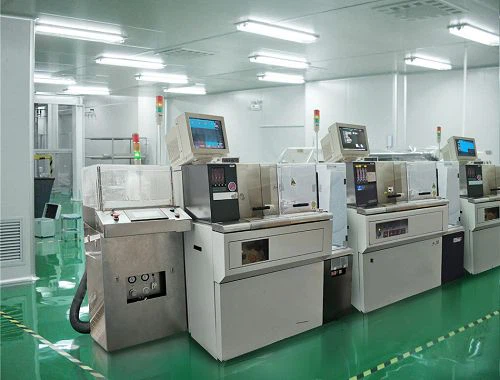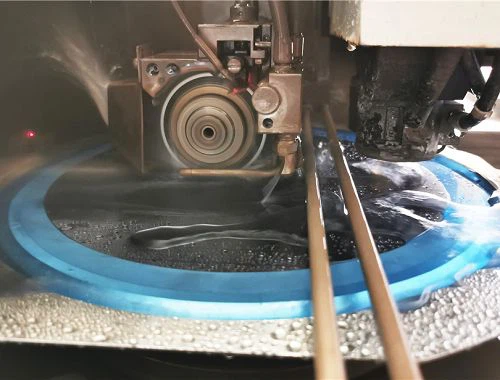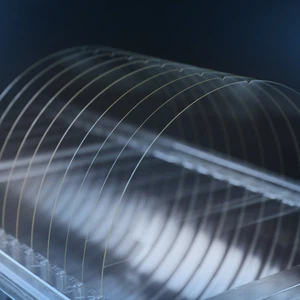Product Description
Monocrystalline silicon cells are usually made from high-purity single-crystal ingots. These ingots are usually grown using the Czochralski method, also known as the crucible pulling process. There are two standard sizes: 12.5 or 15 cm (4 or 5 inches). To obtain cells, the ingots are sliced into thin slices.
Monocrystalline solar panels are solar panels that contain single-crystal solar cells. The panel gets its name from the cylindrical silicon ingots, which are grown from high-purity single-crystal silicon in the same way as semiconductors. Since solar panels are made of single crystals, the electrons have more room to move, allowing for better current flow. The cylindrical silicon ingots are cut into wafers to form cells. To maximize the utility of the cell, the round wafers are cut into octagonal wafers. These cells have a unique look due to their octagonal shape. They are also uniform in color.

|
Specifications of Solar P-type Silicon Wafer |
||||
|
Resistivity (Ω·cm) |
Diameter (mm) |
Thickness (μm) |
Flat to flat length (mm) |
|
|
Common M1 |
0.3-3 |
205 |
170-200 |
156×156 |
|
Common M2 |
0.3-3 |
210 |
170-200 |
156.75×156 .75 |
|
Common M4 |
0.3-3 |
211 |
170-200 |
161.7×161.7 |
|
Thinner monocrystalline silicon |
0.3-3 |
160/205/210/211 |
90-130 |
125-162 |
|
Monocrystalline silicon square wafers |
0.3-3 |
219/220 |
130-180 |
156×156 .75 |
|
Specifications of Solar N-type Silicon Wafer |
||||
|
Resistivity (Ω·cm) |
Diameter (mm) |
Thickness (μm) |
Flat to flat length (mm) |
|
|
Common M1 |
0.1-20 |
205 |
170-200 |
156×156 |
|
Common M2 |
0.1-20 |
210 |
170-200 |
156.75×156 .75 |
|
Common M4 |
0.1-20 |
211 |
170-200 |
161.7×161.7 |
|
Thinner monocrystalline silicon |
0.1-20 |
160/205/210 |
130-180 |
156.75×156 .75 |
|
Thinner monocrystalline silicon |
0.1-20 |
160/205/210/211 |
90-130 |
125-162 |
|
Monocrystalline silicon square wafers |
0.1-20 |
219/220 |
130-180 |
156×156 .75 |
|
PERC Battery |
|
-Average efficiency of cell over 20%, panel power 295W. |
|
-Monocrystalline cell attenuation to less than 2% to promote profitability of power plant. |
|
-Better slot project, equip with high quality metallizing material to ensure the durance of the cell. |
|
-Excellent weak light effect, promote profitability of power plant. |
|
Battery Cells Specifications PERC |
|||||||
|
Specification |
Dimensions (mm) |
Thickness (μm) |
Parameters |
||||
|
Eff (%) |
Power (W) |
Voc (V) |
Impp (A) |
FF |
|||
|
M2-4BB |
156.75*156.75-210 |
160-200 |
21.2 |
5.18 |
0.663 |
9.702 |
80.53% |
|
21.1 |
5.15 |
0.662 |
9.67 |
80.45% |
|||
|
21 |
5.13 |
0.661 |
9.663 |
80.32% |
|||
Product Picture




How do monocrystalline solar panels work?
Monocrystalline solar panels convert sunlight into electricity using single-crystal silicon cells, which are the most efficient type of solar cell. These cells are made by cutting a single silicon crystal into thin wafers.
When sunlight strikes a solar panel, the photons in the light bind to silicon atoms in the solar cell, freeing electrons from the atoms. These electrons circulate through the cell and are collected by circuits. The flow of electrons creates an electric current that can power electronic devices or be stored in a battery for later use.
The efficiency of monocrystalline solar panels depends on the purity of the silicon used in the manufacturing process. Monocrystalline silicon has a more uniform structure than other types of silicon, allowing electrons to flow better through the solar cell. This results in a higher power output per square foot of the solar panel compared to other types of solar panels.

Monocrystalline vs. Polycrystalline Solar Panels
There are many types of solar cells, with monocrystalline and polycrystalline being two of the most popular types. While both are capable of generating electricity, they perform differently. Monocrystalline cells contain a single crystal of silicon, while polycrystalline cells contain multiple smaller crystals.
Monocrystalline solar cells are more efficient than polycrystalline solar cells because they have a uniform crystal structure that facilitates higher levels of electron flow. Additionally, monocrystalline panels are more robust and more resistant to temperature fluctuations, making them a preferred choice for long-term use.
The downside of monocrystalline solar cells is that they are more expensive than polycrystalline solar cells. Additionally, because the cells are made from a single piece of silicon, they are limited in size, and larger installations may require more panels and space.
Polycrystalline solar cells have their advantages. They are generally cheaper than monocrystalline cells, and because of their smaller size, they can be used in areas with limited space. Polycrystalline solar cells are also easier to produce, allowing for more efficient mass production.
Choosing a monocrystalline or polycrystalline solar cell depends on the project and budget. Monocrystalline solar panels are more efficient and durable, but can be more expensive, while polycrystalline cells are cheaper but less efficient. Careful consideration should be given when deciding which cell type is best for your project.
Installation and Maintenance of Monocrystalline Solar
Monocrystalline solar panels are relatively simple to install as they come pre-assembled. The panels should be securely mounted and tilted towards the sun to maximize energy yield. It is important to ensure there are no shadows or obstacles around the panels that would block sunlight.
Monocrystalline solar panels require very little maintenance as they are designed to be rugged and withstand the elements. Cleaning the panels regularly with warm water and a soft cloth will help them perform at their best. However, it is important not to use any abrasive cleaners as these can damage the delicate cells.
Why Choose Us
Our products are sourced exclusively from the world's top five manufacturers and leading domestic factories. Supported by highly skilled domestic and international technical teams and stringent quality control measures.
Our objective is to provide customers with comprehensive one-on-one support, ensuring smooth channels of communication that are professional, timely, and efficient. We offer a low minimum order quantity and guarantee swift delivery within 24 hours.
Factory Show
Our vast inventory consists of 1000+ products, ensuring that customers can place orders for as little as one piece. Our self-owned equipments for dicing & backgrinding, and full cooperation in the global industrial chain enable us prompt shipment to ensure customer one-stop satisfaction and convenience.



Our Certificate
Our company takes pride in the various certifications we have earned, including our patent certificate, ISO9001 certificate, and National High-Tech Enterprise certificate. These certifications represent our dedication to innovation, quality management, and commitment to excellence.
Hot Tags: monocrystalline silicon cell, China monocrystalline silicon cell manufacturers, suppliers, factory, Silicon Photovoltaic Cell, Silicon Photovoltaic Cell
























